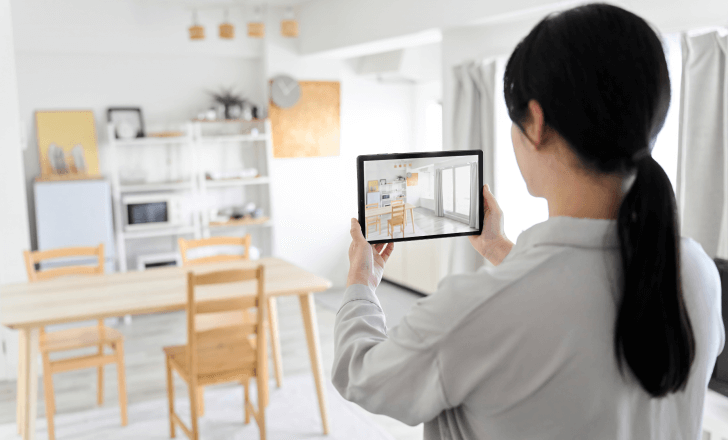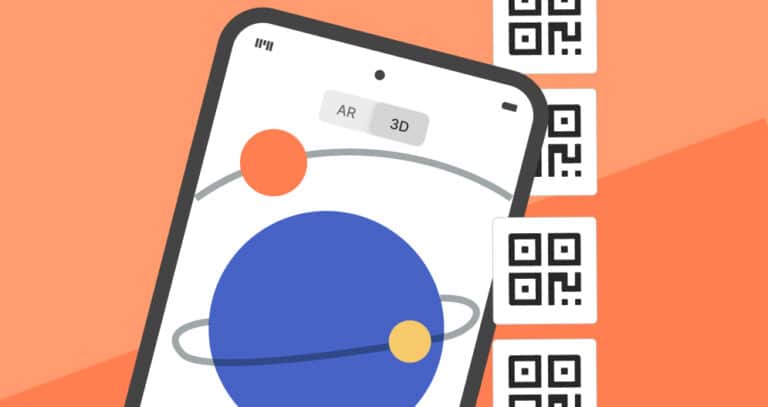Introduction
In an era where technology blends with the physical world to create immersive experiences, QR codes have emerged as a crucial tool in unleashing the potential of Augmented Reality (AR). From marketing and print media campaigns to educational content, the integration of QR codes for AR has transformed the way we interact with the world around us.
Understanding the basics
What are QR codes?
QR codes, those familiar pixelated squares, are not just digital barcodes but powerful gateways between physical and digital realms.
Originally invented for tracking automotive parts, they have evolved into versatile data storage and retrieval tools. When scanned with handheld devices, QR codes direct users to diverse forms of digital content, ranging from simple text to interactive AR experiences.
Augmented Reality (AR): A brief introduction
Augmented Reality (AR) adds layers of digital information to our real-world environment, enhancing our perception of reality.
It’s not just a sci-fi concept anymore but a practical technology used in various fields, from gaming to healthcare. AR alters how we view our surroundings, offering enriched, interactive experiences.
The fusion of QR codes and AR
Combining QR codes with AR creates a synergistic effect. An Augmented Reality QR code serves as a portal, instantly transporting users from a simple printed code to a dynamic, full augmented reality world.
This fusion is pivotal in making AR more accessible and user-friendly.
QR codes in AR applications
AR QR codes in marketing strategy
In marketing, AR codes open new avenues for customer engagement. By scanning a QR code on product packaging or marketing materials, customers can view interactive content, like 3D models of products, or participate in AR-driven brand stories.
This interactive approach captivates the target audience and strengthens brand engagement.
Dynamic QR codes: Bringing interactivity to retail
A dynamic QR code change the retail experience. Imagine walking into a furniture store and scanning a QR code to see how a sofa looks in different colors, all within an AR environment. This level of interaction not only aids in decision-making but also elevates the customer experience.
Let’s say that next week the store wants to promote a dining table: the same dynamic QR code can be recycled with an AR experience of the table. All without reprinting the code.
Incorporating AR codes in brick-and-mortar stores
Brick-and-mortar stores use AR codes to blend physical shopping with digital interactivity. Scanning a QR code can reveal product information, offer virtual try-ons, or guide customers through a store with an AR-assisted map, enhancing the in-store experience.

Technical insights
How an Augmented Reality QR code works
Understanding the mechanics behind AR QR codes is fundamental. At their core, these codes are embedded with data that, when scanned, triggers an AR experience.
These codes are more than mere data containers; they are gateways to immersive experiences. When scanned, AR QR codes activate a device’s camera and use advanced AR technology to superimpose 3D models or scenes onto the real world environment.
This technology blends digital information seamlessly with the physical world, creating an interactive experience where virtual objects appear as part of the user’s surrounding space.
QR code generators and AR
When it comes to creating QR codes for augmented reality, the notion that specialized generators are required is a common misconception. In fact, with QR Code KIT, our versatile QR code generator, anyone can easily craft QR codes capable of unlocking immersive AR experiences.
This makes QR code augmented reality a highly customizable tool for different applications, from marketing campaigns to educational video content. The choice between static and dynamic QR codes depends on the desired level of interaction and data management.
Dynamic vs. Static QR codes in AR
The distinction between dynamic and static QR codes is crucial in AR applications. Static QR codes are unchangeable once created, typically directing users to a fixed piece of content. Dynamic QR codes, on the other hand, are editable and can be updated to redirect to different AR experiences or content over time.
This flexibility makes dynamic QR codes a particularly important feature useful for marketing strategies and interactive experiences, where the content may need to evolve based on customer engagement or other factors.

Marketing and customer engagement
Using QR codes for effective marketing campaigns
In the realm of the marketing campaign, AR QR codes are a game-changer. By incorporating these codes into marketing materials, businesses can transform traditional ads into interactive gateways. For example, a billboard with a QR code can offer a fun interactive digital experience by leading customers to an AR game featuring the product.
This tactic not only captures attention but also enhances brand engagement and memorability.
Customer engagement through AR experiences
The heart of successful marketing lies in deep customer engagement. AR experiences enabled by QR codes can turn passive observers into active participants. Imagine scanning a QR code on a product label and watching the brand story unfold in AR, or seeing how a piece of furniture would look in your living room through an augmented reality experience.
Such interactive elements that incorporate AR codes can significantly elevate the customer and brand experience together, making it more personalized and memorable.

Location-based AR: Connecting physical and digital worlds
Location-based AR, triggered by QR codes at a particular location, offers a unique way to engage customers. For instance, retail stores can use these codes to provide location-specific AR experiences, like showing how a dress would look on a customer in real-time or guiding them through a store with an interactive map.
This integration of physical and digital realms enhances the in-store experience and bridges the gap between online shopping and physical retail.
Advanced applications and case studies
Interactive QR codes in education and training
Interactive QR codes are revolutionizing the education and training sectors. For example, an educational book could have QR codes that, when scanned, bring up 3D models or interactive AR lessons, making learning more engaging and effective.
This interactive digital experience can help students and trainees dive deeper with more accuracy into subjects, providing a richer understanding than traditional methods.
Augmented reality in online shopping
Online retailers are utilizing AR QR codes to enhance the digital shopping experience. By scanning a QR code, customers can see how a product would look in their environment or on themselves.
This application is particularly effective in furniture stores and fashion retail, where seeing a product in context and virtual try-ons can greatly influence purchasing decisions.
Furniture stores: A case study in AR QR code usage
In furniture retail, AR QR codes allow customers to visualize products in their own homes.
Scanning a QR code in a furniture catalog can show potential customers how a piece would look in their living room. This not only aids in decision-making but also adds an element of fun experience to shopping.

Analytics and feedback
Advanced analytics in AR QR code usage
Advanced analytics play a crucial role in understanding customer interactions with an AR QR code. Retailers and marketers can track how often codes are scanned, which products are most viewed in AR, and how these interactions influence purchasing decisions by target customers.
This data is invaluable for refining marketing strategies and enhancing customer engagement.
Customer feedback and AR code technology
Customer feedback is essential in the evolution of AR code technology. By analyzing user responses, businesses can adjust their own AR codes and experiences to be more engaging, informative, and user-friendly.
This continual improvement is key to maintaining relevance and effectiveness in an ever-evolving digital landscape.
Future prospects
The future of AR QR codes
Looking ahead, the potential of AR QR codes is vast. Innovations in Web AR technology and the proliferation of AR-capable devices will likely lead to even better, more creative, and immersive uses of QR codes.
We can anticipate advancements in AR technology that allow for more seamless integration and richer, more interactive experiences.
Challenges and opportunities in AR code technology
Despite the exciting prospects, there are challenges to overcome. Issues like device compatibility, user accessibility, and content quality need addressing.
However, the opportunities outweigh the challenges. As AR and QR code technologies continue to evolve, we can expect them to play a significant role in various sectors, from education to entertainment.
RealityMAX – Enhancing QR codes for AR
RealityMAX: A premier solution for AR QR codes
In the dynamic world of augmented reality experience creation, RealityMAX emerges as a leading solution, arguably the best in its class.
This innovative platform is not just another tool; it’s a game-changer in how we approach AR through QR codes. With its intuitive, no-code, no-download augmented reality features, RealityMAX stands out as a reliable and effective choice for anyone looking to elevate their AR experiences.
Collaborative and real-time 3D design
RealityMAX’s slogan, “The one-stop platform for building, collaborating, and sharing 3D projects,” speaks volumes about its collaborative nature.
This aspect is especially crucial in projects involving QR codes for AR, where teamwork and real-time collaboration can significantly streamline the design and implementation process. With RealityMAX, teams can work together seamlessly, building and refining their AR code experiences that are both engaging and innovative.
Building reliable AR experiences with RealityMAX
Our partnership with RealityMAX underscores our commitment to providing top-notch AR solutions via QR codes. Given its reliable platform, RealityMAX enables us to offer enhanced AR experiences that are both creative and exciting prospects and stable and efficient.
Whether it’s for marketing, education, or entertainment, integrating RealityMAX into your AR QR code strategies ensures that your audiences enjoy a smooth and immersive experience.
The future of QR codes for AR with RealityMAX
Looking ahead, the collaboration between our platform and RealityMAX promises to push the boundaries of what’s possible in the realm of AR and QR codes.
By harnessing the power of real-time 3D collaboration and RealityMAX’s robust platform, the potential for innovative, captivating AR experiences is limitless. We’re excited about this partnership and its myriad possibilities for our clients and their target audiences.

Conclusion
QR Codes for Augmented Reality represent a significant leap in how we interact with digital content. They offer an exciting blend of real and virtual worlds, opening up possibilities for more engaging, informative, engaging content and personalized digital experiences everywhere.
As this technology continues to evolve, it promises to blur further the lines between physical and digital, creating new opportunities for businesses, educators, and content creators alike.

